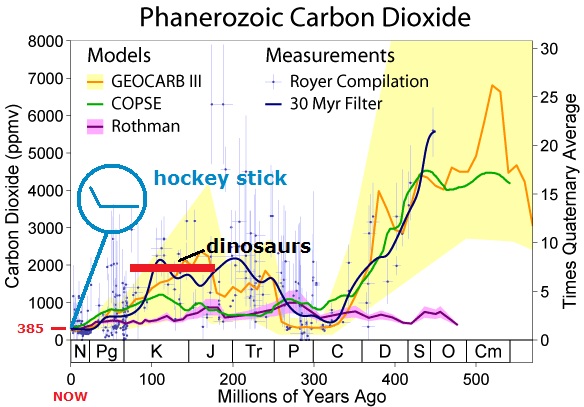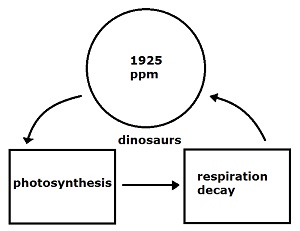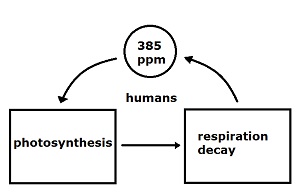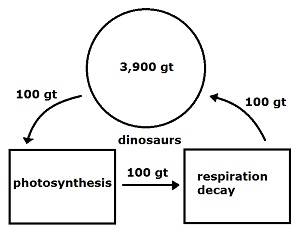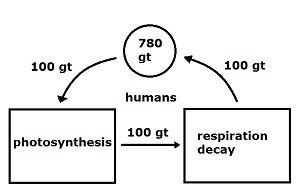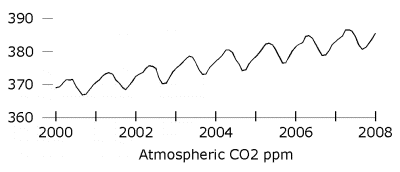|
| Gary Novak
The Cause of Ice Ages and Present Climate |
The Delicate Balance Fraud
Carbon dioxide is not a balance, it's an amount. Plants grow better with more CO2 in the air, because there is a shortage. That's not a balance; it's an amount.
What's delicate and balanced about this? What rationalizers are trying to say is they like the temperature as it is. But it varies every few kilometers north or south. They could just move if they don't like it. But they also say weather will get extreme. It always is and always will be as extreme as 15 kilometers of troposphere will allow. What caused the drought of the thirties, the storms of the 50s or the little ice age a few centuries back? Why is the Sahara desert different from the Amazon rain forest? If humans really did create a "hockey stick" increase in carbon dioxide (from 280 ppm to 385 ppm) and temperature (0.6°C)—and they didn't—why wouldn't it have been an improvement? Al Gore says it's because mosquitos would fly farther north. There are a lot of mosquitos in Canada. How far south are they supposed to stay? If the "tipping point" is when mosquitos fly farther north, who is going to be influenced by it?
As these graphs show, the amount of CO2 in the air can vary independent of photosynthesis and respiration/decay. The amount of carbon dioxide in the air has nothing to do with respiration and decay. Oceans continuously remove CO2 from the air. The number of cars entering a tunnel is exactly balanced with the number of cars leaving the tunnel. It doesn't say whether there is one car in the tunnel or a million. Photosynthesis does not create carbon. Respiration and decay do not create carbon. Where did the CO2 come from, if nothing in nature influences it but photosynthesis, respiration and decay? Was it a stroke of luck that some blind watchmaker provided just the right amount of CO2? And he got it where? The CO2 came from mineral carbonates plus oxidation of volatile hydrocarbons before humans started using the nonvolatile hydrocarbons. Scientists are referring to hydrocarbons (oil, coal and natural gas) as "fossil fuels," assuming they originate with plant material. So humans want to put the plant carbon back into the atmosphere. What was that carbon doing the first time it was in the atmosphere? Frying the dinosaurs? Actually, hydrocarbons were created while the earth formed, not from plant material, but climate alarmists don't know that. Another way "delicate balance" was stated is this: "As this energy radiates back toward space as heat, a portion is absorbed by a delicate balance of heat-trapping gases in the atmosphere..." In other words, alarmists want to contrive a delicate balance concept as an indication of how fragile nature is and how destructive humans are, while they apply the terminology to different effects. "Tipping point" is a similar phrase. Alarmists don't have time to wait for the science, because they have to remove carbon dioxide from the air before a tipping point is reached. What would be a tipping point for carbon dioxide? No explanation, just word salad.
There is no such thing as a delicate balance or tipping point in the major geological effects that nature produces. What controls the amount of CO2 in the air? Oceans regulate it through equilibrium, as studied by Tom V. Segalstad (see IPCC page). If ocean equilibrium regulates, the human input is not relevant. So the delicate-balance hype contains an implicit, if not stated, denial that oceans regulate the amount of CO2 in the air. This question was a central concern of scientists in opposing the global warming theory a few decades ago. But someone said (off the top of his head) that layering in the oceans would cause the top to saturate and stop the regulation process. On the basis of such a quip, the entire global warming issue is built. The amount of CO2 going into and out of the oceans is determined by the surface pH, and it has been stable at an average of about pH 8.1 with no detectable increase in acidity due to human activity. At pH 8.2, less CO2 would be absorbed. At pH 8.0, more CO2 would be absorbed. With the pH stable, CO2 goes into and out of the oceans at a stable rate, except that temperature does something similar. As ocean temperature increases, oceans don't hold as much CO2, and they release more into the air. If oceans are not regulating the amount of CO2 in the air, there is nothing to control the amount, and it would not be stable. Rates going in and rates going out do not determine the amount that accumulates in the air. It's like a warehouse. The amount going in and the amount going out do not say what amount is stored. If biology adds and subtracts the same amount, there are other factors which do not. Geological releases do not add and subtract the same amount. Oceans would not add and subtract the same amount if they were not regulating through equilibrium. Equilibrium is a standard element of chemistry. Water absorbs CO2 readily depending upon the temperature and solutes. It rapidly establishes an equilibrium, where the amount being absorbed is the same as the amount being released. Oceans follow this principle. They absorb more CO2 at colder temperatures and release more at warmer temperatures. They hold less due to dissolved salts. If the oceans were not salty, they would not release enough CO2 for plants to grow on. Frauds claim that one third of the CO2 which humans produce goes into the oceans and two thirds goes into the air. This means 2.8 GTC (Giga tons carbon) goes into the oceans each year, and 5.7 GTC stays in the air. Why is another 2.8 GTC produced by humans going into the oceans next year instead of this year? It’s nothing but a contrivance. There is no measurement or theoretical principle involved. There is 750 GTC in the air. If 2.8 GTC comes from human activity and goes into the oceans, that is 0.37% of the CO2 in the air per year. Why would not 1.1% of the CO2 go from the air to the oceans per year? If it did, all of the CO2 produced by humans would be going into to oceans. Real scientists evaluate and account for such effects. The ones who don't are frauds. There is a huge amount of CO2 in the oceans compared to the amount in the atmosphere. Oceans would be upsetting the "delicate balance," if they were not regulating through equilibrium. In fact, the amount of carbon stored in vegetation, soils, and detritus is three times the amount in the atmosphere. If there were no regulating effect, the amount released from year to year would vary with geological and biological effects. The extreme stability shows that it is regulated. Not only is the amount of CO2 in the atmosphere extremely stable, it is slowly increasing in an extremely uniform manner. Supposedly, humans are the cause, but nature produces effects vastly greater than humans. The miniscule effects of humans are dwarfed by natural effects. Oceans exchange ten times as much CO2 with the atmosphere as humans produce (see numbers below). Humans only add one percent as much CO2 to the air each year as already there. In other words, claiming that the miniscule effects which humans produce is upsetting nature is not credible. The gradual increase in the amount of CO2 in the atmosphere is due to oceans heating and releasing more, not human activity. And it is not a warmer atmosphere which is heating the oceans. A 0.6°C increase in air temperature has no ability to heat the oceans, because there is a thousand times as much heat capacity in the oceans as in the air. In localized areas there is some increase in air temperature due to warmer oceans, not the other way around. 36 Billion Time AS Much Water vapor changes greenhouse effect 36 billion times as much as CO2, day by day. That's not a delicate balance. Water vapor (which is 100 times as much of a greenhouse gas as CO2) can change by a factor of 2 from day to day. CO2 changes by 2 ppm (parts per million) per year. That's 36,500,000,000 times as much change by water vapor as by CO2. A 1°C temperature change due to CO2 in 20 years (0.000137°C per day) would require a 5,000,000°C change due to water vapor from day to day and place to place, if propagandists were producing a consistent logic. Of course, radiation would deplete first, but still, water vapor would swamp anything CO2 does based on the logic of propagandists, and it means there is no "delicate balance" being upset by humans. Some Data "Total human CO2 emissions primarily from use of coal, oil, and natural gas and the production of cement are currently about 5.5 GT C per year (giga tons of carbon per year). A recent update says 8.6 GT. "To put these figures in perspective, it is estimated that the atmosphere contains 780 Gt C; the surface ocean contains 1,000 Gt C; vegetation, soils, and detritus contain 2,000 Gt C; and the intermediate and deep oceans contain 38,000 Gt C, as CO2 or CO2 hydration products. Each year, the surface ocean and atmosphere exchange an estimated 90 Gt C; vegetation and the atmosphere, 100 Gt C; marine biota and the surface ocean, 50 Gt C; and the surface ocean and the intermediate and deep oceans, 40 Gt C." Notice that the oceans exchange ten times as much carbon with the atmosphere as humans produce (90GT vs. 8.6 GT). Exchange means regulation. And humans only add 1% as much CO2 to the atmosphere per year as already in it. If such a miniscule amount were as critical as propagandists claim, all life would have been destroyed long ago. Nature hasn't been sitting on a 1% knife edge for millions of years. Reference:Oregon Institute of Science and Medicine Notice that humans only add 1% as much CO2 to the atmosphere per year as already in it. If such a miniscule amount were as critical as propagandists claim, all life would have been destroyed long ago. Nature hasn't been sitting on a 1% knife edge for millions of years. External Link: early CO2 measurements
|
||||||||||||||||||
 | |||||||||||||||||||


